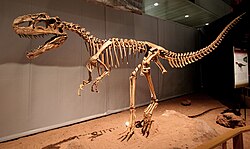Tetanuran
| Tetanurans Temporal range: Early Jurassic–Present, 201–0 Ma |
|
|---|---|
 |
|
| Skeleton of Monolophosaurus jiangi | |
| Scientific classification | |
| Kingdom: | Animalia |
| Phylum: | Chordata |
| Class: | Reptilia |
| Clade: | Dinosauria |
| Order: | Saurischia |
| Suborder: | Theropoda |
| Clade: | Averostra |
| Clade: |
Tetanurae Gauthier, 1986 |
| Subgroups | |
| Synonyms | |
|
Avipoda Novas, 1992 |
|
Avipoda Novas, 1992
Tetanurae (/ˌtɛtəˈnjuːriː/ or "stiff tails") is a clade that includes most theropod dinosaurs, including tyrannosaurids, megalosaurids, ornithomimids, allosaurids, maniraptorforms, and Aves. Tetanurans are defined as all theropods more closely related to modern birds than to Ceratosaurus and contains the majority of non-Aves predatory dinosaur diversity. Tetanurae and Ceratosauria, the other group of theropods, likely diverged during the late Triassic. Tetanurae first appeared in the fossil record by the Early Jurassic about 190 mya and by the Middle Jurassic had become globally distributed.
The group was named by Jacques Gauthier in 1986 and originally had two main subgroups: Carnosauria and Coelurosauria, the clade containing birds and related dinosaurs such as compsognathids, tyrannosaurids, ornithomimosaurs, and maniraptorans. The original Carnosauria was a polyphyletic group including any large carnivorous theropod. Many of Gauthier’s carnosaurs, such as tyrannosaurids, have since been re-classified as coelurosaurs or primitive tetanurans. Carnosauria has been reclassified as a group containing allosaurids that split from the Coelurosauria at the Neotetanurae/Avetheropoda node. Members of Spinosauroidea are believed to represent basal tetanurans.
Tetanuran evolution was characterized by parallel diversification of multiple lineages, repeatedly attaining large body size and similar locomotor morphology.Cryolophosaurus has been claimed as the first true member of the group, but subsequent studies have disagreed on whether it is a dilophosaurid or tetanuran. Arcucci and Coria (2003) classified Zupaysaurus as an early tetanuran, but it was later placed as a sister taxon to the clade containing dilophosaurids, ceratosaurs, and tetanurans.
Shared tetanuran features include a ribcage indicating a sophisticated air-sac-ventilated lung system similar to that in modern birds. This character would have been accompanied by an advanced circulatory system. Other tetanuran characterizing features include the absence of the fourth digit of the hand, placement of the maxillary teeth anterior to the orbit, a strap-like scapula, maxillary fenestrae, and stiffened tails. During the Late Jurassic and Early Cretaceous, large spinosaurids and allosaurids flourished but possibly died out before the end of the Cretaceous, perhaps due to competition from ceratosaurs and tyrannosaurids. Coelurosaurs persisted until the end of the Mesozoic Era, when all except for crown clade avians died out.
...
Wikipedia
